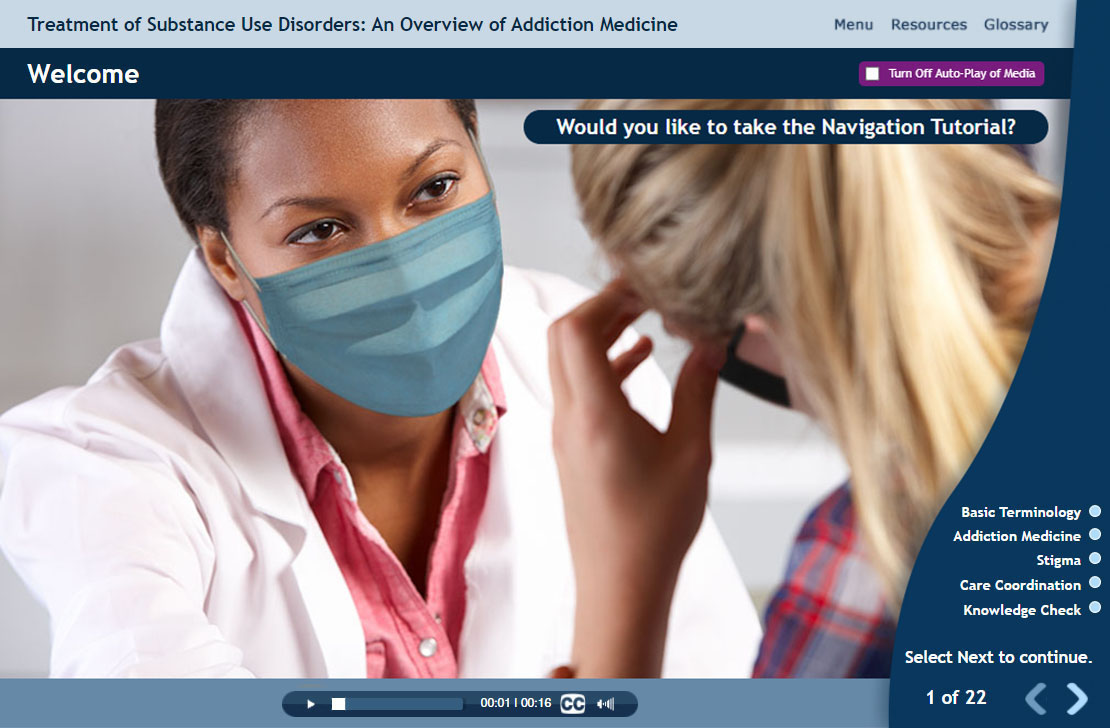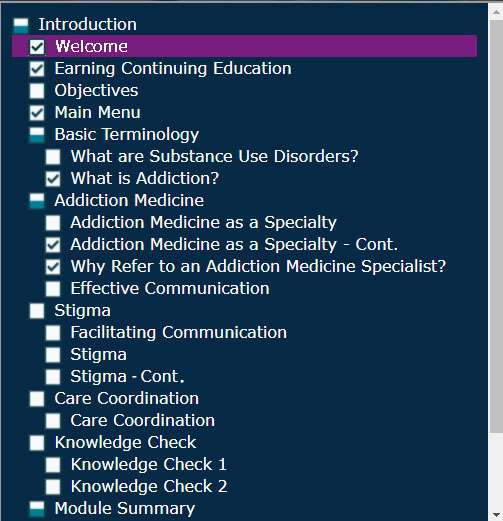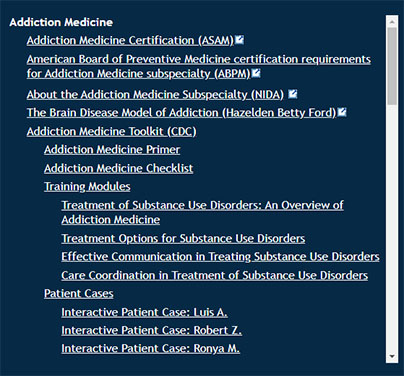Addiction Medicine
Addiction Medicine Certification (ASAM)
About the Addiction Medicine Subspecialty (NIDA) 
The Brain Disease Model of Addiction (Hazelden Betty Ford)
Addiction Medicine Toolkit (CDC)
Treatment of Substance Use Disorders: An Overview of Addiction Medicine
Treatment Options for Substance Use Disorders
Effective Communication in Treating Substance Use Disorders
Care Coordination in Treatment of Substance Use Disorders
Interactive Patient Case: Luis A.
Interactive Patient Case: Robert Z.
Interactive Patient Case: Ronya M.
Interactive Patient Case: Allison H.
The Science of Drug Use and Addiction: The Basics (NIDA)
Buprenorphine
Buprenorphine for the Treatment of Opioid Use Disorder training module (CDC)
Buprenorphine Quick Start Guide (SAMHSA) (PDF)
Care Coordination
SAMHSA Care Coordination for Certified Community Behavioral Health Clinics (SAMHSA)
2022 CDC Clinical Practice Guideline
CDC Clinical Practice Guideline for Prescribing Opioids for Pain— United States, 2022.
CDC's 2022 Clinical Practice Guideline for Prescribing Opioids for Pain training module
Naloxone
When to Offer Naloxone to Patients (PDF)
When to Offer Naloxone to Patients in the Emergency Department (PDF)
Increase Naloxone Prescribing in Your Health System (PDF)
Pharmacists' Role in Naloxone Dispensing (PDF)
What you Need to Know About Naloxone (PDF)
How and When to Use Naloxone for an Opioid Overdose (PDF)
Talking About Naloxone with Patients Prescribed Opioids (PDF)
How to Save a Life with Naloxone (PDF)
Opioid Overdose Prevention
Opioid Overdose Prevention Resources for Healthcare Providers (CDC)
Prevention and Treatment of Substance Use Disorders
Assessing and Addressing Opioid Use Disorder training module (CDC)
Treatment Improvement Protocol (TIP) 63: Medications for Opioid Use Disorder (SAMHSA) (PDF)
Providers Clinical Support System (PSS)
Stigma
Office of National Drug Control Policy Changing the Language of Addiction (PDF)
NIH Words Matter - Terms to Use and Avoid When Talking About Addiction (NIDA)
Language, Substance Use Disorders, and Policy: The Need to Reach Consensus on an "Addiction-ary"
Breaking Through the Wall of Stigma (NIH)
Substance Use Disorders
Common Comorbidities with Substance Use Disorders Research Report (NIDA) (PDF)
Addiction
A treatable, chronic medical disease involving complex interactions among brain circuits, genetics, the environment, and an individual's life experiences. People with addiction use substances or engage in behaviors that become compulsive and often continue despite harmful consequences.1
Care coordination
Information sharing and organization of patient care activities by all clinicians involved with a patient's care in order to achieve safer and more effective results.2
Diagnostic and Statistical Manual of Mental Disorders, Fifth Edition (DSM-5)
A classification of mental disorders with associated criteria designed to facilitate more reliable diagnoses of these disorders.3
Motivational interviewing
A counseling style in which the counselor uses empathic listening initially to understand the client's perspective and minimize resistance. The emphasis is on creating an atmosphere of constructive conversation about behavior change.4
Stigma
Discrimination against an identifiable group of people. For people with substance use disorders (SUDs), stigma may stem from beliefs that people with SUDs are at fault for their disease and are incapable of being treated.5 People with SUDs may internalize this stigma leading to a reluctance to seek help.
Substance use disorders (SUD)
The essential feature of a substance use disorder is a cluster of cognitive, behavioral, and physiological symptoms indicating that the individual continues using the substance despite significant substance-related problems.3
1 American Society of Addiction Medicine. (2019). Definition of Addiction. Retrieved May 27, 2021, from https://www.asam.org/Quality-Science/definition-of-addiction
2 PEW. (2020, April 23). Care Coordination Strategies for Patients Can Improve Substance Use Disorder Outcomes. Retrieved May 27, 2021, from https://www.pewtrusts.org/en/research-and-analysis/issue-briefs/2020/04/care-coordination-strategies-for-patients-can-improve-substance-use-disorder-outcomes
3 American Psychiatric Association: Diagnostic and Statistical Manual of Mental Disorders, Fifth Edition. Arlington, VA, American Psychiatric Association, 2013.
4 Rollnick, S., & Miller, W. R. (1995). What is motivational interviewing? Behavioural and Cognitive Psychotherapy, 23(4), 325–334. DOI:https://doi.org/10.1017/S135246580001643X
5 National Institute on Drug Abuse. (2021, May 25). Words Matter – Terms to Use and Avoid When Talking About Addiction. Retrieved May 27, 2021, from https://www.drugabuse.gov/nidamed-medical-health-professionals/health-professions-education/words-matter-terms-to-use-avoid-when-talking-about-addiction










